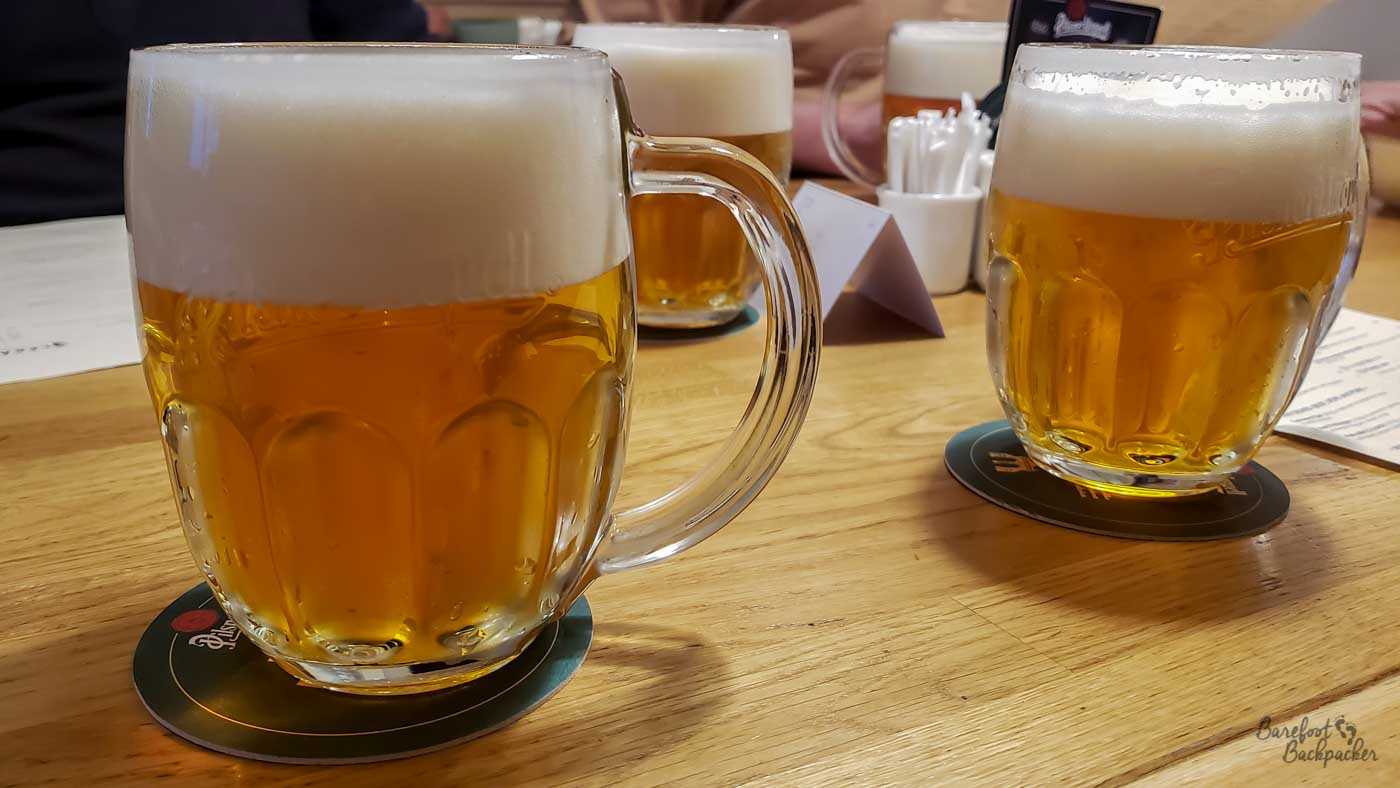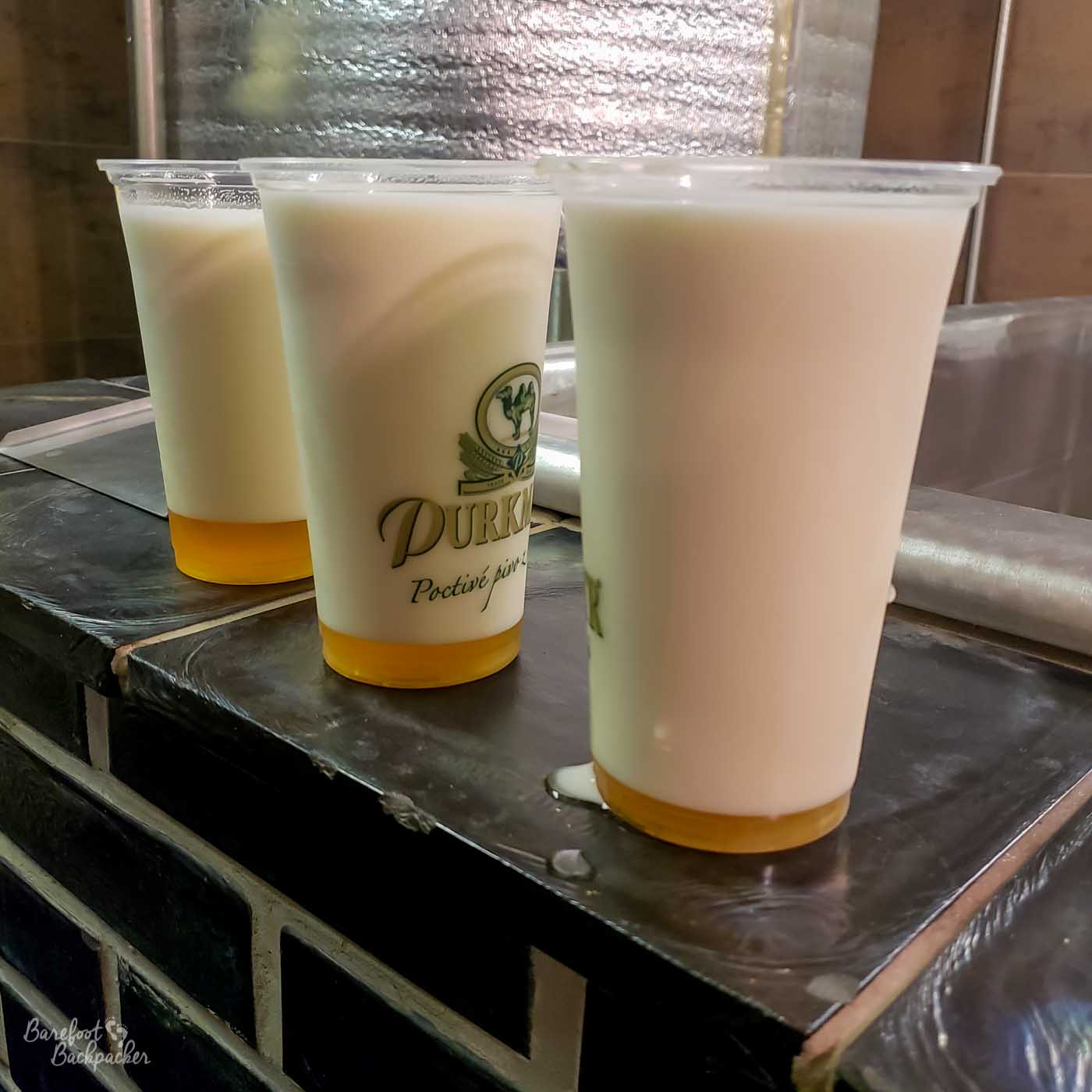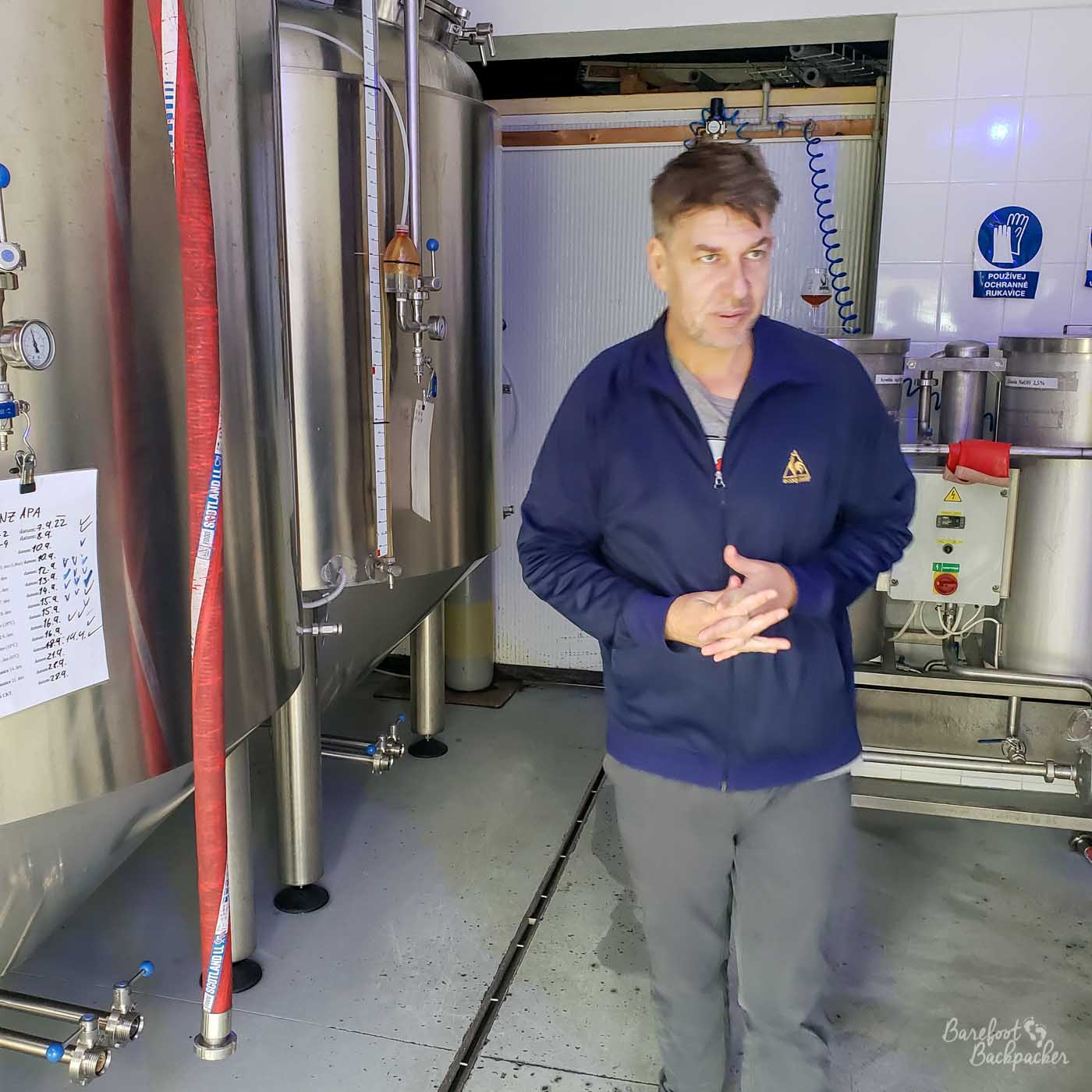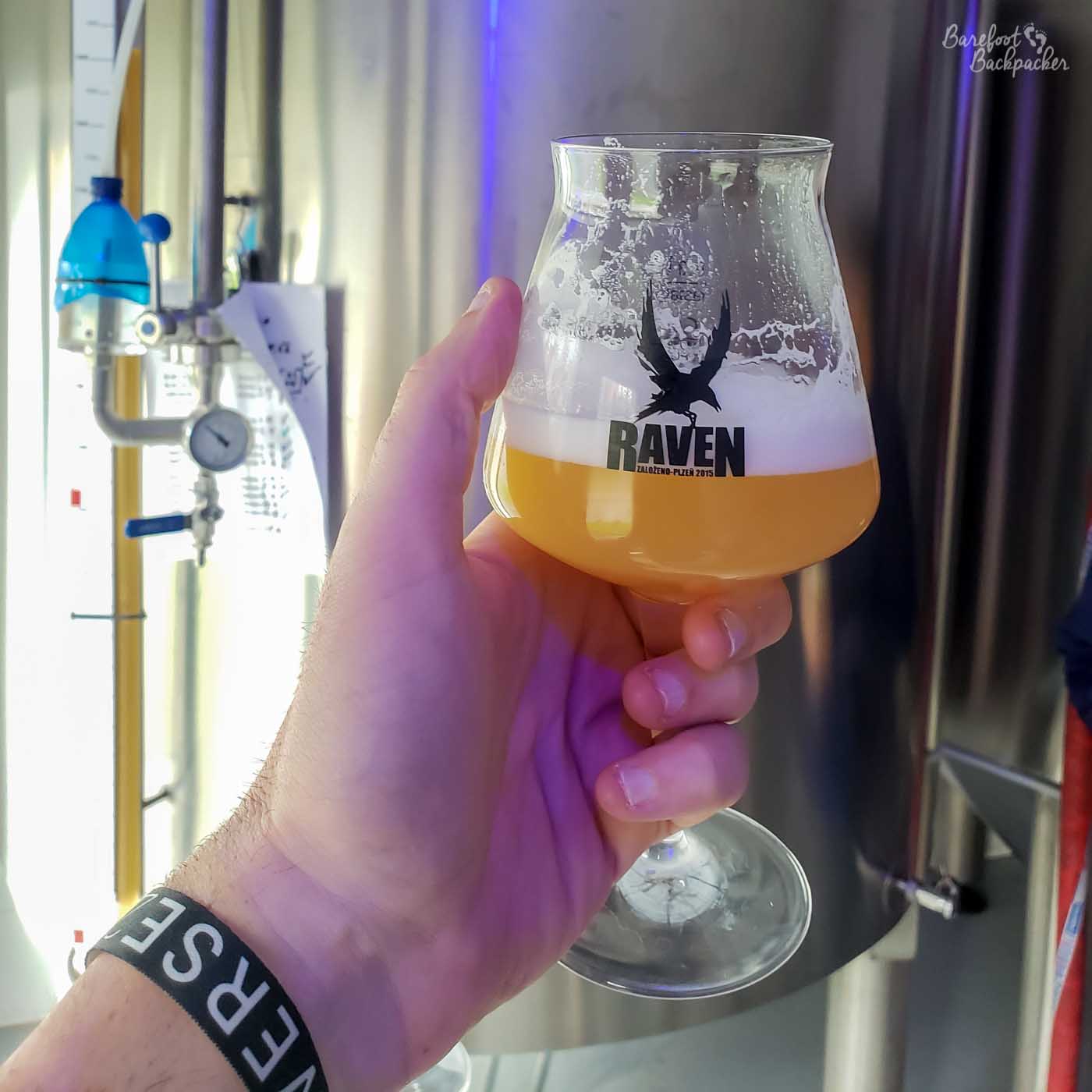Plsen, a city in the west of Czechia, is famous for its beer. Indeed it’s the home of an entire beer style – Pilsner, best exemplified by Pilsner Urquell, which I visited on a brewery tour. In September 2022 I was on a PressTrip to explore more of the beer scene in Plsen, and it was definitely an experience.

Drinking Pilsner-type beer at Pivovar Raven
Beer is very important to the Czechs. It is the country with the highest beer consumption per capita in the world. 140 litres per year, twice as much as the UK, and some 30 litres ahead of second place Austria. It’s not just that the Czechs like beer, it’s more that the whole concept is central to Czech life. In other countries you might meet in a café or at someone’s house for a coffee or a tea. In Czechia you go to the pub and drink a beer together. And there’s a lot of pubs in the country; it’s almost like being in the UK, but bear in mind the UK has almost seven times the population.
Why is Plsen famous for beer?
Plsen is a good site for beer production because the right kind of water flows through the right kind of environment.

Bolevák Pond. Created in the 1400s to serve the fishing and brewing industries of Plsen, the breweries used ice from here to cool their casks of fermenting beers
The city stands where several rivers merge to form the Berounka River. In addition, the town itself has a number of natural springs and the water table’s not too far down, so fresh water is easily available. Importantly though, the water here is primarily quite ‘soft’; that is to say, it contains a much lower concentration of dissolved minerals thus tasting more ‘pure’ and being easier to flavour. Furthermore this part of Europe is a great place for growing barley and hops, the two important ingredients in beer. This explains why, not long after the foundation of the city, the local monks set up a brewery, and why the populace followed not long after. At one point every house in the city centre was licensed to brew and sell beer.
However, just because you can, doesn’t mean you should. Although a lot of nano-breweries existed in the city, their quality was variable and dubious. Remember the average citizen wasn’t a brewer by trade and didn’t have the know-how to make beer consistently well. For a city that prided itself on beer, this was an important consideration. The final straw came in 1839, when a brewed batch was so bad that 36 barrels of it were (allegedly, it must be said) poured out over the town square, presumably in protest. The town council decided enough was enough, and brought in an external consultant. This was Josef Groll, a brewer from nearby Bavaria. He was tasked to use his experience to create a decent brew in the city. Even though he only stayed in charge for a couple of years, his legacy was immense – he was the first brewer at Pilsner Urquell.
How is beer served in Plsen?
It’s important to note there’s different ways of serving beer, specifically Pilsner, in Czechia. The standard way is known as “hladinka” (Czech for ‘level’); it’s tapped in one go at around a 45° angle. This leads to a glass about ¾ full of lager and ¼ foam on top. The principle behind it is that the foam ‘protects’ the beer below it, preventing it from going flat and stale too quickly. This is an alien concept to me as most of the beers I normally drink in the UK are flat by design, but they’re not lagers, so.

Several Hladinka-style glasses of Pilsner
Another popular way is “Šnyt” (‘cut’). This is similar to the Hladinka except the proportion of foam to lager is closer to 50/50. In Czech culture this fulfils the same function as we’d have a ‘half’ in the UK; either we just need a quick drink or we only want a ‘taster’.
There’s also a style that’s almost completely foam. This is the ‘Mliko’ (Czech for ‘milk’). It’s so named because when in the glass, it looks similar to a glass of milk. The idea is you drink it all in one go, though I’m not convinced texture-wise I could. Compared to the other types of presentation, it’s very smooth and sweet. It’s seen as the ‘oh but I’m driving’ drink, given its low volume of actual beer. Note that the drink driving laws in Czechia are somewhat strict; there is no tolerance at all and you are not allowed to drive with any alcohol in your system. It was also traditionally seen as a ‘woman’s drink’, although hopefully those attitudes are disappearing.

Examples of the Mliko style, served up at Purkmistr Brewery
The final style is almost the opposite of Mliko. This is the Čochtan (this seems to mean ‘Neat’, as in ‘neat and tidy’). It’s occasionally known as ‘British Style’. I feel attacked. Anyway it’s served with as little foam as possible – ideally none at all. Without the foam on top it goes flat quickly, but it does mean you can drink it quickly without the foam getting in the way, and it’s said to be refreshing. It must be said I never saw anyone pour this.
Unsurprisingly, the vast majority of the lagers I had on this trip were of the Hladinka style.
Are there microbreweries in Plsen?
Plsen is dominated by Pilsner Urquell, but over ten microbreweries exist, and as part of the Press Trip I was on, we got to experience several of them.
Firstly, two caveats. Although microbreweries tend to be more flexible and experimental with their brewing than large macrobreweries, remember this *is* the Czech Republic. Even a nanobrewery I’d visited back in Brno said that around 80% of their beer output was a variant of Pilsner Lager. The microbreweries in and near Plsen may be numerous and quirky, but even they know what their audience looks like.
The other caveat is the first microbrewery we visited in Plsen, erm, technically isn’t one.

Inside the brewing plant at Pivovar Proud, with many of their beers on display
Proud Brewery is located in the old power station on the Pilsner Urquell site, a short way behind the larger brewery, and 100% owned by it. That said, it operates independently. It’s largely used as a way for the parent company to experiment with styles and tastes that would be very off-brand and out-of-place under the Pilsner Urquell name. Its name comes from its location. ‘Proud’ is a Czech word that means ‘current’, as in ‘electricity’ and ‘water’. It’s a well-considered name, as it’s sited in an old power station where two rivers meet.
Anyway, as a sub-brand, it’s quite a large and elaborate affair for a microbrewery. They’re renovating the old control centre of the power station, which would make a great place to put tables and drink on-site to be honest. Although it’d be a shame to remove the original tiling and the now-very-retro control panel halfway down. But that room itself is bigger than most microbreweries I’ve visited. Also in that room, next to a platform on which are four steel beer tanks, are a crucifix and a bell. This seems to be a traditional religious theme that breweries have, to protect themselves from other kinds of evil spirits. These specific ones however have been blessed by a passing pope, who was also given a batch of Proud beer, which I guess makes it count as holy water?

The brew vats in the old power station control centre. The bell is on the wall to the right, the crucifix below and hidden behind the sign
The main brewing area is relatively large for a small brewery too. They have enough capacity to produce quite a few beers at any one time, and also spirits. On our visit we were given samples of a number of beers they produce, showing the variety of their experimentation. Of course we had the Pilsner-style lager, but also: a red ale with cardamom and black tea, which was sweet, spicy, and earthy; a Plum Sour beer, which definitely tasted plummy; a West Coast IPA (dry, hoppy, and tropical); and a smooth chocolate coffee stout, which was very dry and smokey. According to my notes, I definitely preferred the stout (obviously), but also the red ale, because it was very unusual.
A more standard microbrewery I visited was Raven, based behind a bar/restaurant. We ventured into the brewery itself, a much smaller & crowded affair with a soundtrack of heavy metal. The brewery is run by Filip, an Australian immigrant with a passion for beer. By ‘much smaller’, it was 2-3 rooms and felt quite intimate and crowded even though there were only about 6 of us in there. The first room had a series of vats where beers were in the early stages of brewing. He let us try a little glass of one; the base of a sour beer that had yet to have fruit added to it. It tasted slightly like warm lemon juice.

Filip telling us about his brewery
They produce a wide range of beers, and given Filip’s background, these tend to be more ‘English’ in styles (think IPAs and APAs). They are, however, also quite fond of sour beers, much to my ‘obvious delight’. We ended up sampling six beers here, similar to what you might get in a beer flight. These included: a very hoppy and tropical IPA; another fruity and vibrant IPA; and four sours – a lemon one, a passion-fruit one, an orange one, and a quite peculiar one called ‘brutal lime and salt’ that did exactly what it said on the beer vat. That said, drinking that did confirm that it is specifically tequila I dislike.

The orange sour beer at Pivovar Raven
The brewery has been around since 2015, but in that time has shot up in popularity. It was mentioned in beer literature as amongst the best beer to try in Czechia, and their beers are very popular on the beer app Untappd. They also give back to the wider world; for example they have a partnership with animal charities. One of their beers at the time of my visit was a Tasmanian IPA and for every beer sold, they’d donate to a charity in Tasmania that looks after injured Tasmanian Devils.
The last microbrewery we visited in Plsen itself was Purkmistr. This is quite a large microbrewery, brewing over 150,000 litres per year, which makes it the second biggest brewery in town after Pilsner Urquell. On site also is a restaurant, a hotel, and a beer spa. We did not go in the beer spa.

The restaurant at Purkmistr Brewery
In addition, the brewery has a claim to being one of the oldest in the country. They trace their heritage back to 1341, when beer was first brewed under that name in the town of Domažlice, 50km SW of Plsen and very close to the German border. That brewery closed in 1996 and this microbrewery sprung up some time later, brewing beers to the same recipes.
A couple of the beer tanks are visible from the restaurant, but the majority is in a large room behind. By this stage of our trip we’d seen a lot of the inner workings of breweries and there’s only so many times you can look at something and go ‘oh, that’s a beer kettle’. That said, it is interesting to compare and contrast the different breweries in terms of layout and size, and the way they present. Purkmistr felt much more open-plan than Raven, for instance, which was more subdivided into different rooms.

The brewing room at Pivovar Purkmistr
We sampled their beers in the attached restaurant over a chef-cooked meal. I have a feeling I had rabbit with potatoes, but obviously you’re more interested in the beer. I had a ‘flight’ (6x100ml) of beer, including: the standard lager; a more malty and slightly sweeter version of the standard lager; a malty chocolatey beer; a lemony IPA; a weissbier that tasted of lavender; and what seemed to be a non-alcoholic beer that tasted entirely of malt. It was very odd and … that’s all I really need to say about that one.
We also visited the Zlata Krava microbrewery about 20km south of Plsen, but that was part of a larger experience I talk about on a different post.